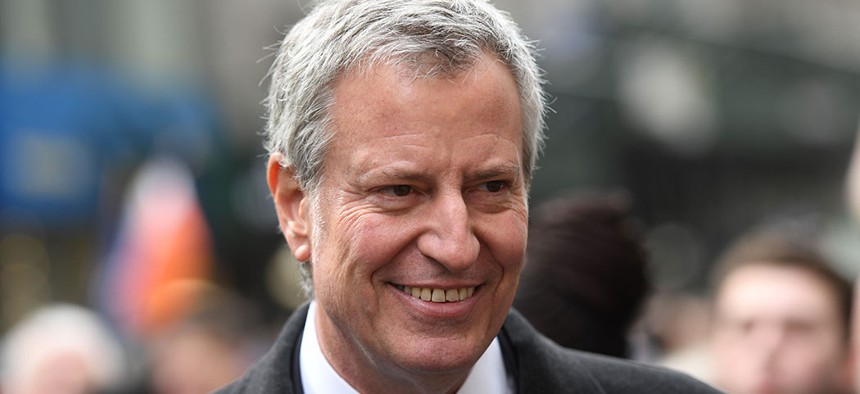New York City
De Blasio should run for president
The press mocks the idea of New York City Mayor Bill de Blasio running for president, but de Blasio’s impressive record of real achievements for working-class New Yorkers means he should run, writes former Obama campaign staffer Kate Albright-Hanna.

New York City Mayor Bill de Blasio. Erik Pendzich/Shutterstock
Pundits have reached a consensus regarding potential Democratic presidential primary contenders: New York City Mayor Bill de Blasio is not hot. He’s no millennial Mayor Pete Buttigieg – the fresh-faced, multilingual leader of the 102,000 residents of South Bend, Indiana. Vanity Fair once declared that de Blasio’s “style is that of a nervous suburban dad trying to be cool in front of his teenager’s pals.” Among New Yorkers, the idea of him running for president is an occasion for eye-rolling disbelief. According to news articles, even the mayor’s allies anonymously call it “f---ing insane.”
Although de Blasio gets mocked by the New York media, his actual record tells a very different story. As the two-term mayor of 8.6 million extremely diverse and opinionated people, he manages more complexity in a day than Buttigieg has confronted in his entire mayoral tenure – and he’s done an excellent job of it.
The two mayors’ signature initiatives reveal radically different approaches to solving problems. In South Bend, Mayor Pete, a former McKinsey & Co. consultant, chose to repair or demolish 1,000 vacant houses in 1,000 days. Ultimately, many residents – mostly poor and people of color – were surprised to find their properties on the demolition list, forced to pay fines, make expensive renovations or lose their investments. That’s what Mayor Pete called “a classic example of data-driven management paying off.”
In New York City, de Blasio campaigned on solving the problem of families scrambling to find safe, affordable, enriching educational environments for their young children. After Election Day, he rallied multiple city agencies to work together, telling them to focus on their deadline as if they were preparing for D-Day. They hit the mark, and saved New York families $1.4 billion in child care expenses by the program’s third year – while also posting consistently improving, high-quality outcomes for their children. Today 70,000 4-year-olds regularly attend free, universal public prekindergarten. Even de Blasio’s critics grudgingly concede that the rollout and implementation have been a success.
While Buttigieg has been criticized for ignoring poverty and the concerns of communities of color, de Blasio has made redressing economic inequality and racial injustice the centerpiece of his political identity. In many ways, his 2013 campaign presaged U.S. Sen. Bernie Sanders’ surprisingly strong showing in the 2016 Democratic presidential primary and the party’s subsequent shift to the left.
Although de Blasio often is accused of “political naïveté” by the snarky New York press corps, he has a record of successfully tackling inherently complex challenges that require managing city bureaucracy and the needs of real human beings.
All of his accomplishments to date – including expanded paid sick leave, funding for neighborhood parks, a free municipal photo ID card, an extension of the city’s living wage law, reduced water bills, expansion of after-school and summer programs, and free wireless broadband for city residents on the wrong side of the digital divide – have focused on easing the cost of living or providing much-needed services to working-class New Yorkers. Daily News columnist Juan González estimates that these policies have made New York City’s residents collectively about $21 billion wealthier.
When de Blasio first ran, his right-wing critics warned that the former leftist radical would cause New York City to descend into a crime-infested wasteland. They have vigilantly searched for ominous signs that the city is falling into violence and decay. Unfortunately for them, de Blasio stubbornly presides over the city’s lowest murder rate in 70 years – while simultaneously overseeing a 98% reduction of stop and frisks between 2011 and 2017.
The critics also warned that rich New Yorkers would flee, but the billionaires keep coming: 84 of them enjoyed de Blasio’s Marxist governance this year, up from 62 in 2013.
Of course, de Blasio also has critics on the left, who point to developments for the super-rich like Hudson Yards as evidence that nothing has really changed since Mayor Michael Bloomberg used taxpayer subsidies to build his luxury city.
Bloomberg made it difficult for any successor to reverse the great concentration of wealth and poverty that de Blasio campaigned against. Even Bloomberg’s admirers bragged in the waning days of his mayoralty that Hudson Yards was “the type of big idea project that defined Bloomberg’s 12 years in office,” and that projects like it “are so far along that there is little the new administration can do to alter or reverse them.”
De Blasio saw the project to completion, but skipped the ribbon-cutting. “We’ve moved away from providing discretionary incentives like the prior administration,” de Blasio said in a statement. “I believe state and local economic development programs need to be reevaluated and updated.”
Of course, de Blasio should have been reevaluating and updating back in 2014 when he was sneaking past the press to get into the Real Estate Board of New York’s annual gala. This year he didn’t show up at all, a recognition that his too cozy relationship with the real estate industry could dampen enthusiasm among the progressive base before his 2020 presidential bid gets off the ground.
There’s no doubt de Blasio is waist-deep in the muck of New York politics, having frequently been caught apparently doing favors for donors. He can’t play the hope-and-change game of a blank slate candidate shape-shifting into anything for anyone.
But with everything on the line in 2020, Democrats need more than hope. They need a candidate who will charge through the muck to get the job done. De Blasio is battle-tested and deserves the chance to make his case.

